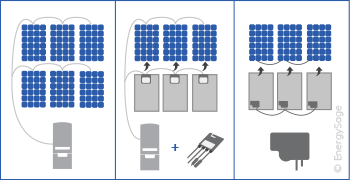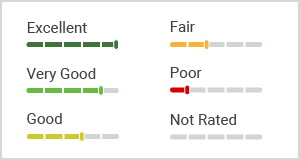Solar Inverters
Get Solar Quotes OnlineEnergySage Buyer's Guide: Solar Inverters
Browse solar inverters from top manufacturers on the EnergySage Buyer’s Guide. To learn about other solar energy system components, visit EnergySage's solar panel and solar battery buyer's guides.
Solar inverters are an essential component in any residential, commercial, or utility-scale solar energy system. Use this guide to compare solar inverter options and understand which products are best for your installation.
564
-
576
of 3,691
564
-
576
of 3,691
Solar inverter buyer’s guide
There are many solar inverters available - how do you know which one is best for you? Some important aspects to consider when selecting a solar inverter include wattage, efficiency, and warranty. All of these aspects plus more are considered in each solar inverters’ quality rating.
What is a solar inverter? Why is it important?
Solar panels produce electricity through the “photovoltaic effect”, which is a physical and chemical process that occurs when sunlight strikes solar cells. The electricity generated during this process is direct current (DC) electricity. However, most appliances run on alternating current (AC) electricity. A solar inverter’s main job is to convert the DC electricity generated by solar panels into usable AC electricity, making inverters vital to the success of your solar panel system.
Types of solar inverters
There are three main types of inverter technologies available for your solar installation: string inverters, power optimizers, and microinverters. Both string inverters and power optimizer systems use a central inverter to convert the electricity from all of your panels from DC to AC, while microinverters convert DC electricity to AC electricity at each individual solar panel.
String inverters aggregate the output of groups of solar panels in a system into “strings”, which are then connected to a single, central inverter where electricity is converted from DC to AC electricity. With a string inverter, you can connect multiple “strings” of panels to the same central inverter, allowing some flexibility with your solar panel system design. However, string inverters do not provide panel-level optimization, which makes them less suitable for installs where you expect shading throughout the day or with complex roofs. String inverters are typically the least expensive inverter option, and are a great option for homes that receive consistent sunshine and with straightforward rooftops.
Power optimizers are located at each individual panel and are paired with a central inverter to complete the conversion from DC to AC electricity. Power optimizers don’t convert electricity to alternating current, rather, they “condition” the DC electricity to optimize its voltage before sending it to a string inverter to be converted. This results in a higher overall system efficiency compared to using string inverters alone in shading scenarios. In situations where you anticipate individual panels to experience a drop in production throughout the day due to shading or other factors, power optimizers can help reduce overall system inefficiencies.
Microinverters are also located at each panel site, but are not paired with a string inverter. Unlike power optimizer systems, microinverters convert electricity from DC to AC right at the panel. This approach also leads to optimized electricity production when compared to using a string inverter alone in shading scenarios or on complex roofs. By converting DC electricity to AC electricity right at each panel site, microinverters can also minimize the system-wide effects of a single panel under-performing.
Microinverters and power optimizers are often collectively referred to as Module-Level Power Electronics, or MLPEs for short. As a group, MLPEs offer several specific benefits when compared to traditional string inverters, including shade tolerance and individual panel monitoring options. However, MLPEs typically come with a higher price tag than string inverter options, so it’s worth comparing all of your options to see what is best for your specific solar installations.

Comparing solar inverter options
There are many ways to compare solar inverters. Here are a few key metrics to keep in mind:
Efficiency
A solar inverter’s efficiency is indicative of how well it converts DC electricity from solar panels into usable AC electricity. With any electrical conversion process, energy is lost in the form of heat – the lower the energy losses, the higher the efficiency. Higher efficiency inverters are typically more expensive but will help maximize the electricity output of your panel system.
Warranty
Many solar inverter companies provide a warranty offering of at least 10 years, but some will offer up to 25. Importantly, check to see if your solar inverter is warrantied for the same length of time as your solar panels are. If you’re looking for added peace of mind, many inverter manufacturers offer extended warranties for an additional price (or your installer may offer it for free as an added perk of choosing their quote).
The EnergySage solar inverter rating system
The EnergySage classification system incorporates technical specifications for solar inverters to compare their performance, durability, warranty and overall quality. By assessing each product across a range of metrics, the EnergySage rating system groups equipment into five different classifications: Poor, Fair, Good, Very Good and Excellent.
Solar inverters rated as Poor or Fair are at the low end of what is currently available in the market, or may be outdated models no longer produced by manufacturers, and rarely stocked by solar installation companies. Equipment receiving Good, Very Good or Excellent ratings must meet a baseline set of criteria rigorously developed so that you can be confident that your solar energy system will meet your needs.

Other solar inverter resources
Inverter types: An overview of the major types of solar inverters.
Microinverters vs. power optimizers: Learn how the two MLPE options stack up against one another.
Solar inverter sizing: All about how solar inverters are sized to match your solar panel system.